Text
Source: World Economic Forum, 2021
1 in 10 people on the planet don’t have access to clean water. And 800 children die everyday because of diseases caused by drinking dirty water. A simple solution like this could save millions of lives.
#climate change#environment#biodiversity#ecology#forest#science#sustainability#geology#water#savelives
211 notes
·
View notes
Text
A method to heavily reduce our carbon footprint and save millions of trees: using coconut husks as a replacement for wood.
Each year, more than 70 billion coconuts are consumed and their hairy shells become waste.
Dutch start up company Cocopallet decided to make pallets out of them that are stronger, cheaper and much more sustainable than the wooden alternative. They have developed a technique to press 100% bio-based export compliant pallets for Asian exporters.
Currently, these exporters use 1.7 billion wooden pallets per year, causing 170 million trees to be harvested. CocoPallet saves millions of trees, heavily reducing our carbon footprint while paying farmers for their waste and saving costs for customers.
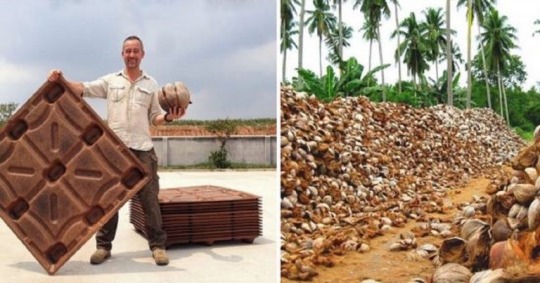
Source: Coconet, 2021
69 notes
·
View notes
Text
Source: World Economic Forum 2021
This technique can boost yields by 100-150% in a natural, easy and cheap way. It is a solution for drought and famine caused by climate change and can be used widely by farmers in dry areas.
43 notes
·
View notes
Text
Video: demonstration of smog eating buildings, Mashable, 2020
An easy, cost-efficient, low-maintenance solution for air pollution: Buildings that automatically clean out the air
Air pollution is a big problem we face, in over half of 1,600 cities surveyed is now above safe limits of Particulate Matter.
In Delhi, found to have the worst pollution in the world, around 10,000 people die prematurely each year because of pollution.

Image: Flickr, Ben Amstutz
Imagine a city in which all the buildings automatically clean polluted air without the need for expensive filtration devices. It sounds like something from a futuristic world, but the reality is that the substance titanium dioxide (TiO2) – which occurs in nature – is already making this fight against pollution a reality.
Special grades of titanium dioxide can remove harmful nitrogen oxides in the air through ‘photocatalysis’ – a process where light speeds up a naturally occurring chemical reaction called photolysis. Photocatalysis results in the rapid conversion of nitrogen oxides into harmless soluble nitrate salts which are removed from a building’s surface by rainfall.
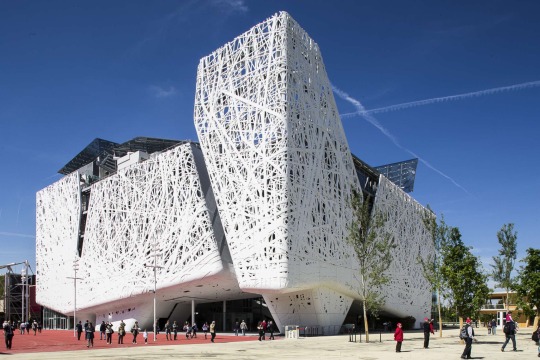
Image: Palazzo Italia, smart building that uses TiO2, PlaceTech, 2020
By painting buildings, or using preformed materials containing these special grades of titanium dioxide, you can create this reaction on a large scale.
This means that the TiO2 based coatings will continuously remove the pollutants from the air, making it a cost-effective and low-maintenance solution.
Source: TDMA, 2020
#climate change#environment#biodiversity#ecology#science#sustainability#cities#engineering#air quality#pollution#smartcity
162 notes
·
View notes
Text
Source: World Economic Forum, 2021
This planting technique boosts seedling survival rates from 10% to at least 90%, even in dry areas. A simple and nature based solution that helps fight climate change.
#climate change#environment#biodiversity#ecology#forest#science#sustainability#geology#plantlife#plants
9K notes
·
View notes
Text
Picture: Standing forest, Green City Solutions, 2020
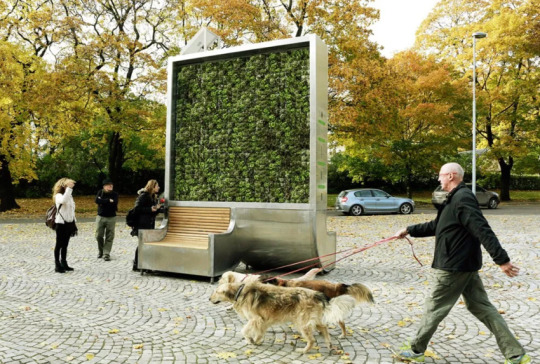
Created by start-up Green City Solutions, the freestanding, vertical units are covered in moss and lichens which have a massive surface area to absorb particulate matter, nitrogen dioxide and ozone.
The trees’ inventors estimate that a single structure has the environmental benefits of 275 urban trees, but taking up 99% less space and at just 5% of the cost.
Growing on units four metres high and three metres deep, CityTrees are powered by solar panels and collect rainwater in troughs. They also require little maintenance: via the internet of things, soil humidty, nutrient levels and general plant health are monitored and adjusted accordingly.
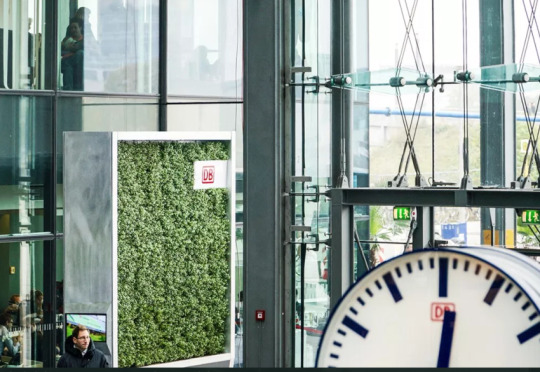
Picture: Green City Solutions, 2020
Source: World Economic Forum, 2020
107 notes
·
View notes
Text
Picture: Vertical forest in Italy, Milan, World Economic Forum, 2020

An innovative way to plant trees in dense cities: vertical forests
Short on space, people in cities have often looked upwards for places to expand. In Milan, Italy, architects have done the same with tree cover – creating a "vertical forest" on two residential tower blocks. Boasting 800 trees, 4,500 shrubs and 15,000 plants, the "forest" would cover an area the size of three and a half football pitches if planted on the ground. Similar projects are underway in cities in Switzerland, The Netherlands and China.
The proposed Liuzhou Forest City is the most ambitious project yet: a new town with homes for 30,000 people, where buildings will be covered by 40,000 trees and 1 million plants.

Picture: Liuzhou Forest City, World Economic Forum, 2020
Each year the trees will absorb 10,000 tonnes of CO2 and 57 tonnes of pollutants. They should also produce about 900 tonnes of oxygen.
Boeri’s team of architects say the plants will also decrease the average air temperature, create noise barriers and boost biodiversity by creating a habitat for birds, insects and small animals.
Source: World Economic Forum, 2020
274 notes
·
View notes
Text
Picture: Endeavor Business Media, 2021

One of the most sustainable, efficient and effective ways for green energy: Space-based solar power
In the near future, solar power collected in space and beamed down to Earth could power military and civilian installations, vehicles and devices in remote places across the globe.
The foundational technology is already in hand, and the first small-scale demonstration project will be ready for launch in 2023
Apart from providing around-the-clock power on demand beamed from space, the new solar cells, panels and production processes being developed through the program could revolutionize space-based power systems in general and terrestrial photovoltaic installations by offering higher-efficiency systems at much lower cost than is available today.
“If we are successful in reducing all the high-cost solar cell fabrication processes, we may enable the use of these high-efficiency cells in broader civilian and commercial applications,” Horowitz said in a statement. “These include applications that require higher power per area and value flexibility, like on ships, electric vehicles or portable devices.”

Picture of space solar power technique, source: Space Legal Issues, 2019
The AFRL is also working on the antenna technology for solar-beaming to create robust metrology to steer precision radio frequency beams wherever needed, said SSPIDR program manager Winter.
“It will offer a continuous power supply, unlike terrestrial systems where darkness and rain interfere,” Winter said. “All you need is a rectifying antenna to receive power from space anywhere on the globe.”
Source: Albuquerque Journal, 2020
7 notes
·
View notes
Text
Picture: New Atlas, 2021
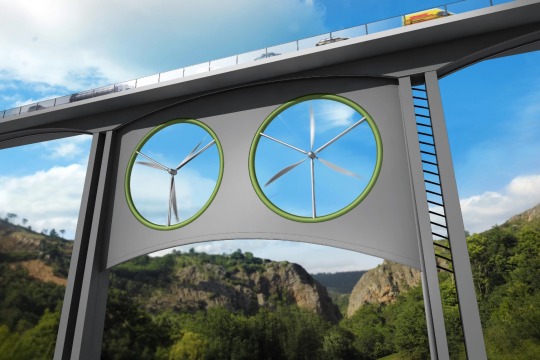
An efficient way to create sustainable energy without situating them in an open space: Windturbines built in a bridge.
Wind turbines might be common sight all around the world, but situating them in open fields or on breezy ridges isn't always a practical option. Ideas like placing turbines under bridges have been proposed, but is that a viable alternative? According to new research out of Europe, the answer is yes
The study showed that the best way to create power would be to use two different-sized turbines, or even to create a matrix of 24 small turbines because of their low weight and the amount of power that can be produced by each unit.
In terms of practicality, however, the study suggests that the best option would be to use two identical medium sized 0.25 MW turbines, which could theoretically generate enough energy to power 450-500 homes, as well as reduce CO2 emissions compared with fossil fuel sources.
"This kind of installation would avoid the emission of 140 tons of CO2 per year, an amount that represents the depuration effect of about 7,200 trees," said researcher Oscar Soto.
Source: New Atlas, 2021
37 notes
·
View notes
Text
Picture: Vox Media, 2021

A new and innovative way to build our cities: The use of sustainable cement.
By 2050, 80% of the world’s population is expected to live in cities.
However, the ability to construct engineering masterpieces such as the Millau Viaduct and the Burj Khalifa comes with a high environmental cost. Cement production alone (excluding other aspects of construction) accounts for around 8% of global CO₂ emissions, about half of which results from chemical reactions inherent in the production process. As other industries such as energy and agriculture reduce their share of emissions, cement production may account for nearly a quarter of all human-driven CO₂ emissions by 2050.
Many low-CO₂ cements have emerged as attractive, more sustainable alternatives to traditional Portland cement. Portland cement is produced by heating a mixture of limestone and other minerals to around 1,450°C, a process that results in chemical reactions that release large amounts of CO₂.
But other materials are also widely used in concrete, including those largely generated from industrial waste or by-products such as coal fly ash, blast furnace slag, calcined clays, finely ground limestone or silica fume. They are used either by blending with traditional cement, or as a binder (or “glue”) themselves, without any Portland cement.
Importantly, the way these materials are produced results in far lower CO₂ emissions than Portland cement. This can reduce CO₂ emissions by between 50% and 80%, depending on the technology used.
Using these materials in cement provides enhanced strength and durability, and also improves sustainability by reducing associated CO₂ emissions and recycling industrial wastes.
Source: World Economic Forum, 2021
4 notes
·
View notes